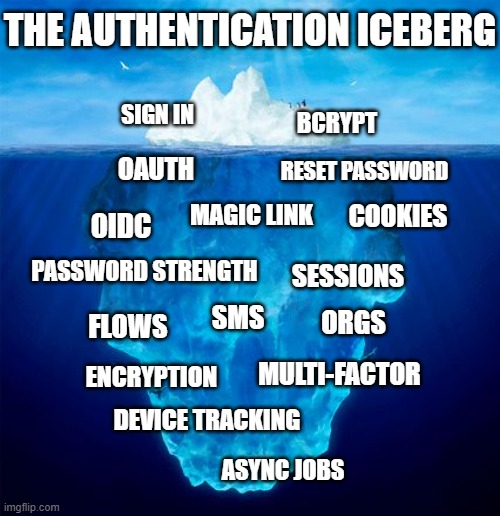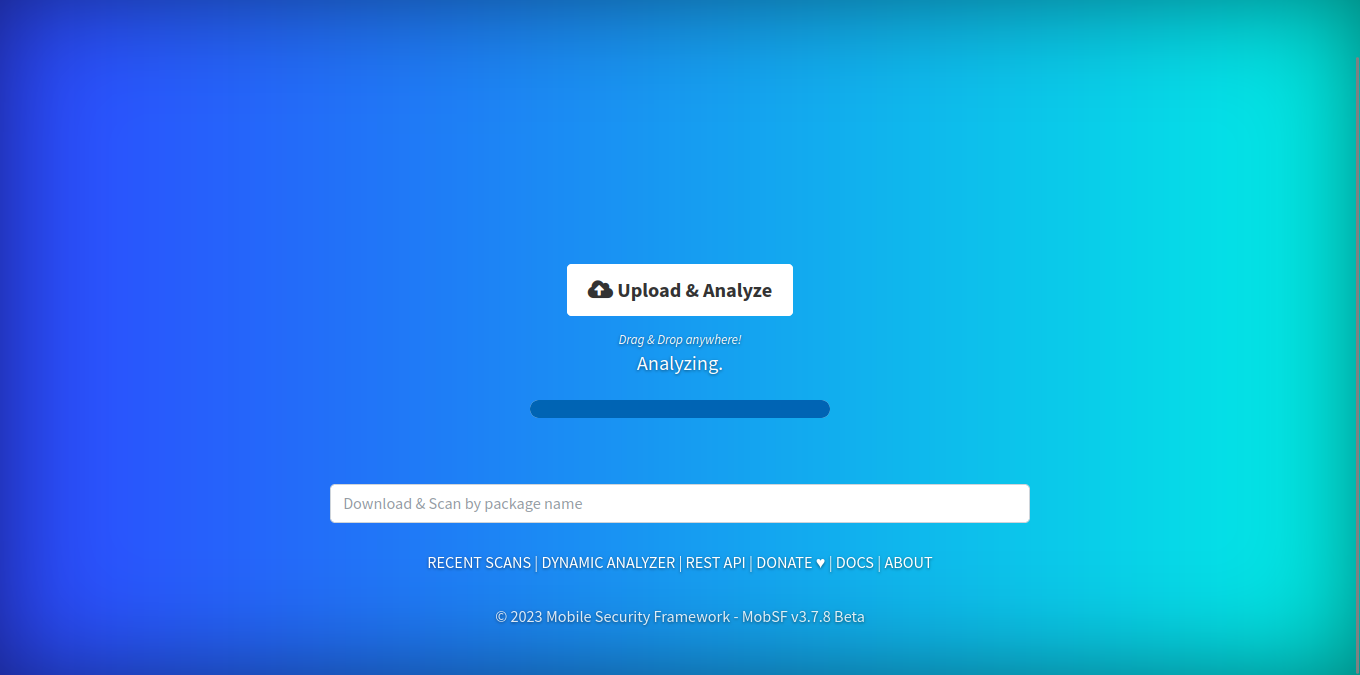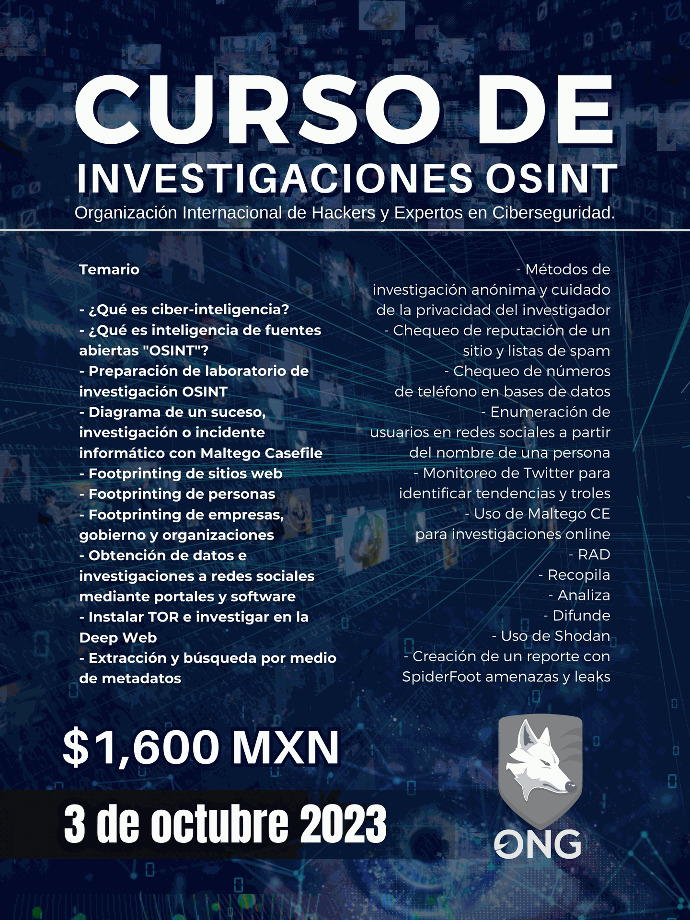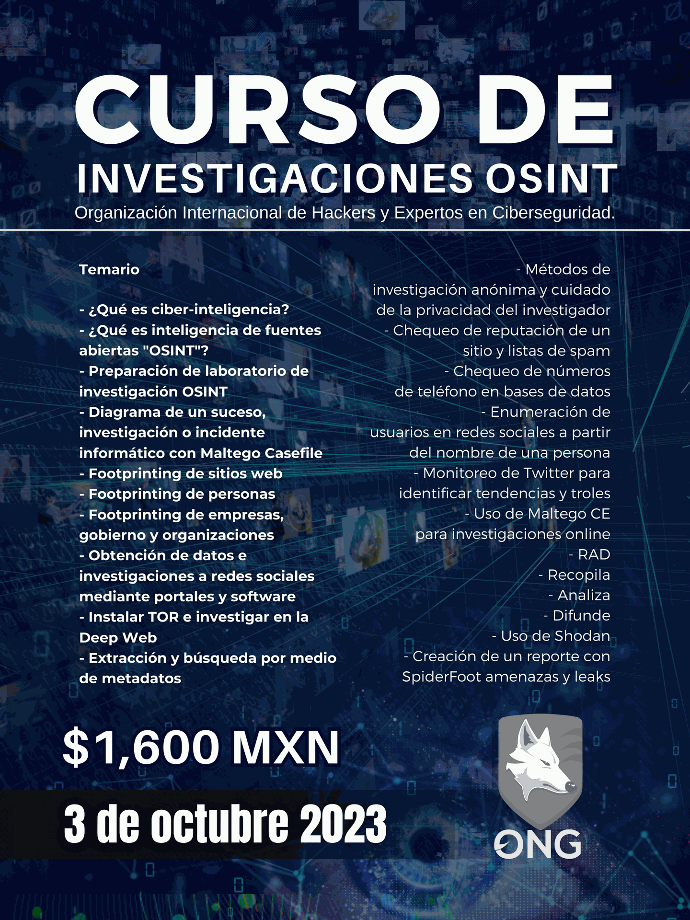
Intelligence
Requisites
Introduction
What is Intelligence?
Intelligence is the set of activities to obtain information in the economic, labor, commercial, financial, military, personal, family, and social fields, among others, of an objective human organization (cooperative or adversary), turning it into knowledge (a useful report for leaders decide on a course of action), with the goal of causing harm or taking precautionary measures. Counterintelligence is protecting yourself from these activities.
Since computer security is the protection of the assets of a computer system where it shields against deliberate threats from adversery agents. On the contrary, computer safety shields against accidents, mishaps and external organizationl disasters. We consider cybersecurity a Intelligence subfield and computer safesty a reliability engineering.
Computer security analyzes computer-based systems, which comprise hardware, software, product vendors, algorithms, programs, interfaces, software processes, databases, communication protocols, and designs. The goal is to identify their vulnerabilities and associated threats to prevent incidents by implementing control activities.
A vulnerability refers to a weakness in the system, while a threat is the condition that can exploit that vulnerability. An incident occurs when someone takes advantage of the vulnerability using the threat. Control activities are policies, mechanisms and an extra system design considerations taken to prevent and respond to such incidents. TODO: Zero day, known, unknown, apt,.
Availability, integrity, confidentiality, authentication, nonrepudation (or accountability), auditability measure the security of the system because they enable us to measure the value of information that parties share to each other.
Confidentiality, Integrity and Availability ensure that an asset can be viewed, modified, or used only by authorized parties, respectively [AND73]. These properties together form the Security Triad or CIA triad. ISO 7498-2 added authentication and nonrepudiation. The former confirms the identity of a sender, while the latter ensures that a sender cannot convincingly dispute their authorship. The U.S. Department of Defense added auditability. It traces all actions related to some interesed asset.
Contrary to the concepts of security, fabrication, interception, modification, and interruption are considered harmful actions. A fabrication attack introduces illegitimate information into the system, while an interception attack gains access to confidential information. An interruption attack degrades a system or renders it unavailable for legitimate use. A modification attack threatens the integrity of the information.
Physical security
Alice and Bob
The attacker mindset
Types of Attackers
Terrorists, hackers, criminal-for-hire, individuals, governments, organized crime members, loosely connected group.
Geopolitics
Hacking, hackers, crackers, ….
https://www.youtube.com/watch?v=k_zz3239DA0&ab_channel=JohnnyHarris
Risk
Roles of Compliance and Auditors
Attack methodologies
Cyber Kill Chain
ATT&CK
Diamond Model
Why does Intelligence matter to you?
Ecosystem
Standards, jobs, industry, roles, …
Hacker One
Red teams
bug bounty hunter
Gadgets
Research
Conferences
DEF CON
BugCon
Economics
Certifications
Beginner certifications are CompTIA A+, CompTIA Linux+, CompTIA Network+, CompTIA Security+, CCNA. Advanced certifications are CISSP, CISA, CISM, GSEC, GPEN, GWAPT, GIAC, OSCP, CREST, CEH.
Jobs
Intelligence Analysts
Culture
https://www.youtube.com/watch?v=przDcQe6n5o&ab_channel=Google
Capture the flag (CFT) and labs
CFT is an contest to find hidden text strings in vulnerable systems. Some the plataforms that offers to play CFT over the Internet are HackTheBox, TryHackMe, VulnHub, picoCFT, SANS Holiday Hack Challenge.
Some nice people offers labs to practice in a safe and reproducible environment the different attacks. In particular, we recommend you SEED Security labs by Wenliang Du, his book and lectures are wonderful to learn cybersecurity.
https://seedsecuritylabs.org/index.html
https://www.handsonsecurity.net/
Tricks
https://book.hacktricks.xyz/welcome/readme
Story
Disclaimer
Refer to
FAQ
Worked examples
Backups
Backups are essential for data recovery and business continuity. Implementing best practices ensures that your backups are reliable, secure, and fit the purpose. Here's a rundown of the key best practices for backups:
- 3-2-1 Rule:
- Keep at least 3 copies of your data.
- Store 2 backup copies on different devices or mediums.
- Keep 1 copy offsite, away from your primary location.
- Regularly Schedule Backups:
- Automate backups to occur at regular intervals, such as daily, weekly, or monthly.
- Adjust the frequency depending on the importance and frequency of changes in your data.
- Test Your Backups:
- Regularly test restoring from backups to ensure data integrity and that the restoration process works.
- Document and familiarize your team with the restoration process.
- Encryption:
- Encrypt backups to ensure data confidentiality, especially for sensitive data.
- Use strong encryption algorithms and keep encryption keys secure.
- Retention and Rotation:
- Determine how long you need to keep backup copies (retention period) based on legal, regulatory, and business requirements.
- Implement a rotation scheme (e.g., Grandfather-Father-Son) to manage multiple backup versions.
- Monitoring and Notifications:
- Monitor backup processes for failures or issues.
- Set up notifications or alerts for backup successes, failures, or other significant events.
- Backup Storage and Media:
- Use reliable backup storage media.
- Store offsite backups in a secure, environmentally controlled location to protect against natural disasters and theft.
- Periodically replace or refresh storage media to ensure durability.
- Versioning:
- Keep multiple versions of your backups to protect against data corruption, accidental deletions, or ransomware that might corrupt recent backups.
- Incremental and Differential Backups:
- Instead of always taking full backups, use incremental or differential backups to save time and storage.
- Incremental backups save changes since the last backup (whether full or incremental).
- Differential backups save changes since the last full backup.
- Instead of always taking full backups, use incremental or differential backups to save time and storage.
- Isolate Backup Systems:
- Keep backup systems separate from the main network to protect against ransomware and other threats.
- Backup Application Settings and Configurations:
- Alongside data, back up application settings, configurations, and system states to ensure quick recoveries.
- Stay Updated:
- Regularly update and patch backup software to protect against vulnerabilities.
- Document Everything:
- Maintain comprehensive documentation of backup policies, procedures, schedules, and restoration processes.
- Ensure key personnel are familiar with these documents.
- Review and Adjust:
- Periodically review and adjust backup strategies as your business needs, technologies, and threat landscapes evolve.
Lastly, remember that the end goal of backups isn't just to have a copy of your data but to be able to restore and use that data when needed. Always approach backups with recovery in mind.
Authentication and authorization

Identification and Authentication, federated identity managment, multicator authentication, secure authentication, authentication based on biometrics, on phrases and facts, on tokens.
IAM
PAM
https://www.youtube.com/watch?v=5uNifnVlBy4
Ensure Authority and Authorization with Access control
Accesss policies
Implementing access control
Procedure-oriented access control
Role-based access control
General issues in access control
Firewalls
Secure mobile code
Denials of service
Secure naming
Reference architecture
Lightweight Directory Access Protocol
SSO
SML and OpenID
Full-suite
Certificates
Local Auth
Kerberos
OpenID
RADIUS
Identity management
Helpers
Yubikeys
Password manager
Two-factor authentication
Zero-knowledge architecture
Zero-trust
Zero-knowledge proof
https://www.youtube.com/watch?v=HUs1bH85X9I&ab_channel=Computerphile
https://www.youtube.com/watch?v=cI5lkif-V1c&ab_channel=ALEXonScience
https://www.youtube.com/watch?v=yn6CPQ9RioA&ab_channel=IBMTechnology
IETF protocol for AAA
Kerberos
Open Radius
OAuth
SAML. Security Assertion Markup Language.
Multi-tenant
SASL2 https://www.gnu.org/software/gsasl/
Authentication, authorization, and accounting framework
Security management
Key management
Vault
Secure group management
Authorization management
Accounting
Worked examples
Notes
FAQ
Further resources
Cryptography
The first methods of encryption was simple, these algorithms hide the messages by substitution and transposition of plaintext characters.
1.1 Introducción
1.1.1 Criptografía
1.1.2 Criptosistema
1.1.3 Esteganografía
1.1.4 Criptoanálisis
1.1.5 Seguridad
1.2 Teoría de números
1.2.1 Números primos
1.2.2 Teorema de Fermat y Euler
1.2.3 Álgebra modular
1.2.4 Teorema chino del residuo
1.2.5 Logaritmos discretos
2.1 Sustitución monoalfabética
2.1.1 Sistema criptográfico de César
2.1.2 Cifrado con alfabeto decimado
2.1.3 Cifrado afín
2.1.4 Criptoanálisis de sistemas monoalfabéticos
2.2 Sustitución polialfabética
2.2.1 Sustitución con homófonos
2.2.2 Cifrado de Vigenère
2.2.3 El método original de Vigenère
2.2.4 Criptoanálisis del sistema de Vigenère
2.3 Sistemas poligráficos
2.3.1 Sistema poligráfico de Playfair
2.3.2 Sistema de cuatro cuadrados
2.3.3 Sistema de dos cuadrados
2.3.3.1 Sistema vertical de dos cuadrados
2.3.3.2 Sistema horizontal de dos cuadrados
2.3.4 Sistema de Hill
2.3.5 Criptoanálisis de sistemas poligráficos
2.4 Sistemas históricos de llave larga
2.4.1 Cifrado de Vernam y seguridad perfecta
2.4.2 ENIGMA
2.4.3 PÚRPURA
3.1 El estándar de cifrado de datos - DES
3.1.1 El origen de DES
3.1.2 Descripción de DES
3.1.3 Redes de Feistel
3.1.4 Algunas propiedades de DES
3.1.5 Llaves débiles, semi-débiles y posiblemente débiles
3.2 Propiedades algebraicas de DES
3.3 Criptoanálisis de DES
3.3.1 Red de Feistel simplificada: RFS
3.3.2 Criptoanálisis diferencial de RFS
3.3.3 Criptoanálisis lineal
3.4 Criptografía de llave pública
3.4.1 Criptografía de llave pública
3.4.2 Intercambio de llaves de Diffie-Hellman
3.4.3 Criptosistemas de envío de mensajes Massey-Omura
3.4.4 Criptosistema de ElGamal
3.4.5 Criptosistema RSA
3.5 Criptoanálisis de sistemas de llave pública
3.5.1 Ruptura contra ruptura total
3.5.2 Problemas asociados a los criptosistemas de llave pública
3.5.3 El problema del logaritmo discreto
3.5.4 El problema de factorización
4.1 Firmas hash
4.2 Herramientas criptográficas
4.2.1 TOR
4.2.2 Ransomware
4.2.3 PGP, SSL, SSH
4.2.4 VPNs & IPSec
4.2.5 TLS
JOSE (JWE, JWT, JWS)
Paseto
Entropy
Salting
Hash functions
HMAC
Hardware security modules (HSM)
https://github.com/Ciphey/Ciphey
Symmetric algorithms
AES, Blowfish
Asymmetric Algorithms
Rabin Algorithm, RSA Algorithm
Key exchange
ECDHE
DHE
ECDH
DH
RSA
PSK
Public-Key Cryptography Standards (PKCS)
Encryption
Symmetric cryptography
Asymmetric cryptography
PKI
Digital signatures
Keys and certificates are stored in a lot of different formats, but hopefully it is easy convert from one format to another. Some of the most common formats are:
DER certificate. It contains the data in its binary form, using ASN.1 encoding.The most of the time you find DER certificates with .crt .cer .der extensions.
PEM certificate. It contains the data from DER in ASCII format, using base64 encoding with a header -----BEGIN CERTIFICATE----- , and a footer -----END CERTIFICATE-----.
Legacy OpenSSL key format. SSLeay compatible.
PEM key
PKCS #7. The format for the transport of signed or encrypted data in plain text.
pkcs7=sign(certificate,private_key, data)
PKCS #8 key. The new format for the private key.
PKCS #12 (PFX) key and certificate
https://www.openssl.org/docs/man1.1.1/man1/openssl-rsa.html
Applied Cryptography, Second Edition: Protocols, Algorthms, and Source
Code in C (cloth)
Public key infrastructure
Certificate authority
Cryptographic Message Syntax
X.509
ASN.1
PEM files
BER (Basic Encoding Rules)
Certificates
.key, .csr, .pem
.der
.cert, cer .crt
.p7b, .keystore
.crl
PEM
PKCS7
DER
Goverment, law and handwritten signatures
Mexico have accepted digital signatures
https://www.diputados.gob.mx/LeyesBiblio/pdf/LFEA_200521.pdf
http://www.economia.unam.mx/publicaciones/econinforma/369/08leonizquierdo.pdf
https://www.zimuel.it/blog/sign-and-verify-a-file-using-openssl
Worked example.
Client side. forge
Server side. openssl
Bulletproof SSL and TLS
PGP and GPG
PGP (Pretty Good Privacy) is a product invented by Phil Zimmermann in 1991 and is currently developed by Symantec Corporation. In contrast, OpenPGP is a standard that expands upon PGP. GnuPG (GNU Privacy Guard) is a free software implementation of the OpenPGP standard. There are various GUI (Graphical User Interface) clients, such as Kleopatra, KGpg, and Claws Mail, that facilitate the operation of GnuPG. It is also important to note that each programming language and operating system may have its unique implementation or method for integrating GnuPG. Indeed, GnuPG can be utilized in conjunction with several programming languages and operating systems, including PHP, Python, JavaScript, Unix, and Windows. For managing asymmetric cryptography, GnuPG is an alternative to OpenSSL. Similar to OpenSSL, you can sign and encrypt data with PGP. However, PGP differs in that it utilizes a web of trust for its operations, as opposed to the X.509 certificates and root entities used by OpenSSL.
gpg -c filegpg --decrypt file.asc
gpg --search-key DF0925CFEC52C98E4CEB826ADB57E52EDEE4E4D2
echo "Hello World! This is important. My real name is [email protected]" | gpg --encrypt --sign --armor -r DF0925CFEC52C98E4CEB826ADB57E52EDEE4E4Dgpg --armor --export DF0925CFEC52C98E4CEB826ADB57E52EDEE4E4D2
# Prints the GPG key ID, in ASCII armor formatWeb of trust
Social proof
https://security.stackexchange.com/questions/18197/why-shouldnt-we-roll-our-own
(Admin), X. G. (2022). A Practical Guide to GPG Part 1: Generate Your Public/Private Key Pair. LinuxBabe. Retrieved from https://www.linuxbabe.com/security/a-practical-guide-to-gpg-part-1-generate-your-keypair
Ellingwood, J. (2017). How To Use GPG to Encrypt and Sign Messages. DigitalOcean. Retrieved from https://www.digitalocean.com/community/tutorials/how-to-use-gpg-to-encrypt-and-sign-messages
Security and Cryptography. (2022, October 27). Retrieved from https://missing.csail.mit.edu/2020/security
GPG Keys Cheatsheet. (2022, November 02). Retrieved from https://rtcamp.com/tutorials/linux/gpg-keys
Spam?
Spam protection for public GPG keys? (2022, November 02). Retrieved from https://security.stackexchange.com/questions/119271/spam-protection-for-public-gpg-keys
https://www.cs.umd.edu/~jkatz/papers/cryptography.pdf
https://www.youtube.com/watch?v=AS66q6ykLCs
https://github.com/sobolevn/awesome-cryptography#articles
https://www.feistyduck.com/library/openssl-cookbook/online/
Steganography
The poor cousin of Cryptography
Security by obscurity
Machine Identification Code
https://www.eff.org/pages/list-printers-which-do-or-do-not-display-tracking-dots
https://github.com/KuroLabs/stegcloak
https://www.youtube.com/watch?v=Py-qu9KWXhk
https://www.sentinelone.com/blog/hiding-code-inside-images-malware-steganography/
Sec lists
https://github.com/danielmiessler/SecLists
References
- Baumslag, G., Fine, B., Kreuzer, M., & Rosenberger, G. (2015). A Course in Mathematical Cryptography. De Gruyter. Available at: EBSCOhost [Clásica].
- Bock, L. (2021). Modern Cryptography for Cybersecurity Professionals: Learn how you can leverage encryption to better secure your organization's Data. Packt Publishing Ltd.
- Fúster, A. (2012). Criptografía, protección de datos y aplicaciones: una guía para estudiantes y profesionales. Alfaomega. [Clásica].
- Jimeno, M. T., Caballero, M. A., Míguez, C., Matas, A. M., y Heredia, E. (2012). La biblia del hacker. Anaya Multimedia. [Clásica].
- Maiorano, A. (2009). Criptografía: técnicas de desarrollo para profesionales. Alfaomega. [Clásica].
- Musa, S. M. (2018). Network Security and Cryptography. Mercury Learning & Information. Available at: EBSCOhost
- Paar, C. & Pelzl, J. (2010). Understanding Cryptography. Springer. [Clásica].
- Arboledas, D. (2017). Criptografía sin secretos con Python. RA-MA Editorial. Available at: EBSCOhost.
- Menezes, A. J., van Oorschot, P. C., & Vanstone, S. A. (1997). Handbook of Applied Cryptography. CRC Press. [Clásica].
Secure channels
Ciphersuite
A cyphersuite consists of the Key Exchange, Authentication, Encryption and Hashing protocols agreement between two parties.
TLS, secure and unsecure protocols
https://www.ssllabs.com/ssltest/
SSL, HTTPS, …
SSL Pinning
Checkm8 Exploit
https://frida.re/docs/android/
https://github.com/sensepost/objection
HTTP Public Key Pinning
https://appinventivinsider.medium.com/how-to-bypass-ios-ssl-pinning-7a65ea149e69
https://gupta-bless.medium.com/ssl-pinning-is-it-really-secures-us-from-mitm-attacks-6626787e9e1e
IPSec
Plain text
Proton Email
Signal, Keybase
SSH
Matrix (social app)
VPN
WireGuard, OpenVPN, IPsec, L2TP, IKEv2, Tinc, PPTP
Full disk encryption
cryptsetup + LUKS on Linux, BitLocker on Windows, or FileVault on macOS.
tor vs vpn
One, T. H. (2020, February 08). Tor vs VPN | Which one should you use for privacy, anonymity and security. Youtube. Retrieved from https://www.youtube.com/watch?v=6ohvf03NiIA&ab_channel=TheHatedOne
References
Baumslag, G., Fine, B., Kreuzer, M. & Rosenberger, G. (2015).
A Course in Mathematical Cryptography. De Gruyter.
https://search.ebscohost.com/login.aspx?
direct=true&db=e000xww&AN=1016960&lang=es&site=
ehost-live [Clásica].
Bock, L. (2021). Modern cryptography for Cybersecurity
Professionals: Learn how you can leverage encryption
to better secure your organization's Data. Packt
Publishing Ltd.
Fúster, A. (2012). Criptografía, protección de datos y
aplicaciones: una guía para estudiantes y profesionales.
Alfaomega. [Clásica].
Jimeno, M. T., Caballero, M. A., Míguez, C., Matas, A. M., y
Heredia, E. (2012). La biblia del hacker. Anaya
Multimedia. [Clásica].
Maiorano, A. (2009). Criptografía: técnicas de desarrollo para
profesionales. Alfaomega. [Clásica].
Musa, S. M. (2018). Network Security and Cryptography.
Mercury Learning & Information.
https://search.ebscohost.com/login.aspx?
direct=true&db=e000xww&AN=1809143&lang=es&site=
ehost-live
Paar, C. & Pelzl, J. (2010). Understanding Cryptography.
Springer. [Clásica].
Tor
Nonce
Programs
Buffer overflow
Secure programming
https://www.youtube.com/watch?v=jeLuKUGho0A
https://www.youtube.com/watch?v=SBGZCIwkNw8&ab_channel=redcudimexico
https://www.youtube.com/watch?v=YjMViAgoIFo&ab_channel=redcudimexico
Obfuscation
Reverse engineering
https://blackarch.org/reversing.html
Drivers
Linux programs
Windows (.exe)
Android apps (.apk)
Generally, we’re working with emulator such as Andoird Studio AVD Emulator or Genymotion. In our case, we’re going to work with Genymotion because by default are rooted. We’ve chosen Samsung Galaxy S7, Android API 12, and we’ve installed Magisk such that we can install some interesting modules.
Mobile Security Frawework MobSF
https://github.com/MobSF/Mobile-Security-Framework-MobSF

Frida
Medusa
https://github.com/Ch0pin/medusa
TODO
https://blackarch.org/mobile.html
https://owasp.org/www-project-mobile-app-security/
iPhone apps (.ipa)
Cyber forensics
Web security
Web server settings
TLS
HPKP
Cipher suite
https://ssl-config.mozilla.org/
SSL Pinning
Public-Key-Pins: pin-sha256="base64=="; max-age=expireTime [; includeSubDomains][; report-uri="report"]API REST
OWASP
https://owasp.org/www-project-web-security-testing-guide/latest/
Proxies
https://apps.apple.com/mx/app/surge-5/id1442620678
https://infosecwriteups.com/frida-objection-without-jailbreak-27a66501bf38?gi=770230767a38
https://github.com/KJCracks/Clutch
https://github.com/BishopFox/bfinject
Bursuite
Fiddler
CAIDO
TamperDev
mitmproxy
https://chrome.google.com/webstore/detail/hackers-toolkit/iebkeiopbbfnmieadmojmocohdmaghmb
Zed Attack Proxy (ZAP)
Postman
https://twitter.com/LiveOverflow/status/1709461266979307633
SPA
Save all dynamic resources with Save All Resources.
References
- LeBlanc, J., & Messerschmidt, T. (2016). Identity and Data Security for Web Development: Best Practices. O'Reilly. [Clásica]
Operating systems
Hardening
Kon-Boot
USB Protection
USB Rubber Ducky
https://github.com/USBGuard/usbguard
Networks
nslookup
iptablesg
packet sniffers
ipconfig
netstat
port scanners
piong
ding
arp
protocol analyzers
nmap
route tcpdump
tracert
Man-in-the-middle
IMSI Catchers
Firewalls
Term origin
When firefighters try to stop the spread of a forest fire, they burn the area surrounding it. This is area called a firewall.
pfSense and OPNSense
Suricata
Snort
tcpdump
Honeypots
Databases
IBM Cloud Education. (2019, August 27). Database Security: An Essential Guide. Retrieved December 10, 2021, from IBM Cloud.
Raj, P., & Deka, G. C. (2018). A Deep Dive into NoSQL Databases: The Use Cases and Applications. Elsevier.
Savas, O., & Deng, J. (2021). Big Data Analytics in Cybersecurity. Auerbach.
Cloud computing
The internet of things
Social engineering
Management and Incidents
Preparation, identification, containtmenet, eradication, reovery, leassons learned.
Standards
ISO/IEC 27001 CIS, ISO27005, ISO27017, ISO27018, ISO27035, ISO27701 and NIST.
OWASP
Intrusion Detection System
.6.1 IDS
3.6.2 IPS
3.6.3 SIEM
Intrusion Prevention System
References
- Chio, C., & Freeman, D. (2018). Machine Learning and Security: Protecting Systems with Data and Algorithms. O'Reilly.
- Verma, R. M., & Marchette, D. J. (2020). Cybersecurity Analytics. CRC Press, Taylor & Francis Group.
- Chakraborty, R., Ghosh, A., & Mandal, J. K. (2021). Machine Learning Techniques and Analytics for Cloud Security. Wiley.
- Saxe, J., & Sanders, H. (2018). Malware Data Science: Attack Detection and Attribution. No Starch Press.
Secure system development
Blue team, red team and purple team
Penetration Testing
Devops
Hardening Checklists
MAC-based
NAC-based
Port blocking
Group policy
ACLs
Sinkholes
Patching
Jump Server
Endpoint Security
Isolation
References
Information Security Best Practices: 205 Basic Rules by George L Stefanek
Defensive Security Handbook: Best Practices for Securing Infrastructure
Secure Coding: Principles and Practices by Mark G. Graff, Kenneth R. van Wyk
Conklin, W. A., White, G. B., Cothren, C., Davis, R., & Williams, D. (2018). Principles of Computer Security: CompTIA Security+ and Beyond (Exam SY0-501). McGraw-Hill Education.
Chebbi, C. (2018). Mastering Machine Learning for Penetration Testing: Develop an Extensive Skill Set to Break Self-Learning Systems Using Python. Packt Publishing Ltd.
Diogenes, Y., & Ozkaya, E. (2018). Cybersecurity - Attack and Defense Strategies: Infrastructure Security with Red Team and Blue Team Tactics. Packt.
Intelligence assessment
Tail OS
Intelligence assessment, Intelligence or Intel (information gathering)
Espionage
Edward Snowden
Useful idiot
Strategic intelligence
Military intelligence
Business intelligence
Police intelligence
OSINT
Surveillance
5 eyes alliance
Cyberwarfare
Operation Aurora
Mass media
Libres, L. V. n. h. (2018, April 13). LAS NOTICIAS SON PROPAGANDA - ABRE LOS OJOS. Youtube. Retrieved from https://www.youtube.com/watch?v=naleYSK-5y8&t=15s&ab_channel=LaVerdadnosharálibres
References
Institutions
National Intelligence Centre in Mexico
Literature
Lerner, K. Lee and Brenda Wilmoth Lerner, eds. Encyclopedia of Espionage, Intelligence and Security (2003)
La seguridad nacional de México, una visión integradora
https://www.youtube.com/watch?v=tUjBpvxupq8&ab_channel=ADNOpinión
Research
Journal of Information and Intelligence
Virus and Malware
Antimalware and antivirus
clamav
squid
Resources
"Malicious Software" de Eric L. Freudenthal,
"The Art of Computer Virus Research and Defense" by Peter Szor,
The Giant Black Book of Computer Viruses by Mark Ludwig
"Computer Viruses and Malware" by Markus Jakobsson and Zulfikar Ramzan
Computer Viruses, Artificial Life and Evolution: The Little Black Book of Computer Viruses by Mark Ludwig
Computer Viruses and Malware by Jonh Aycock
https://github.com/mav8557/virus
Privacy, legal issues, ethics and Law
Digital content
Sources
sci-hub
https://thepiratebay.org/index.html
https://rutracker.org/forum/index.php
References
Inside Network Perimeter Security (2nd Edition). Northcutt, Zeltser, Winter and Ritchey. 2005.
Wenliang Du - Computer & Internet Security_ A Hands-on Approach-Wenliang Du
Castellanos , Luis R. (2015). Seguridad en Informática. Ed. Académica Española ,
Herzog, P., Jordan, M. B., Monroe, B., & Norman, G. (2015). The Network Security Essentials: Study Guide & Workbook-Volume 1. ISECOM.
Kizza, J. M. (2015). Guide to computer network security. Springer.
Pfleeger, C. P., & Pfleeger, S. L. (2015). Security in computing. Prentice Hall Professional Technical Reference
CompTIA Security
Matt, B. (2005). Computer security e art and science. 003-02-14)[2009-05-23].
Smith, R. E. (2015). Elementary information security. Jones & Bartlett Publishers.
Stewart, J. M. (2014). CompTIA Security+ Review Guide: Exam SY0-401. John Wiley & Sons
Wells, N. (2000). Guide to Linux Networking and Security. Course Technology Press
https://www.cert.org/information-for/home_networks.cfm
CTF
USB Keystroke Injection Protection
Enlace Hacktivista. (2022, September 19). Retrieved from https://enlacehacktivista.org/index.php?title=Enlace_Hacktivista
OWASP
https://www.youtube.com/watch?v=ZrXhoT_tXFE&ab_channel=%24DebugSec%24
Rafael Bucio ⠠⠵ on Twitter. (2022, October 01). Retrieved from https://twitter.com/Bucio/status/1575987501457494016
Children education
Welcome to Mara Turing Official Website for UK. (2021, March 07). Retrieved from https://maraturing.us
Mara Turing: El despertar de los hackers (The Awakening of the Hackers)
Physical security and cybersecurity – are they so different?
Security and Cryptography. (2022, October 27). Retrieved from https://missing.csail.mit.edu/2020/security
The Hated One - YouTube. (2022, October 30). Youtube. Retrieved from https://www.youtube.com/c/TheHatedOne/videos
[AND73] Anderson, J. “Information Security in a Multi-User Computer
Environment,” in Advances in Computers, v12, 1973, p1–35.
Folker, R. (2016, August 22). Intelligence Research & Collection. Youtube. Retrieved from https://www.youtube.com/watch?v=onfCJiw6iEI&ab_channel=RobertFolker
TODO

